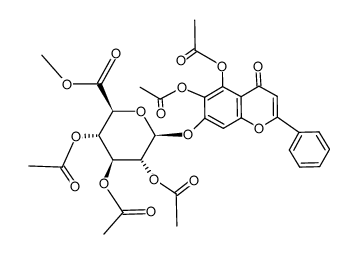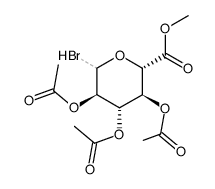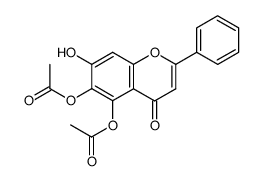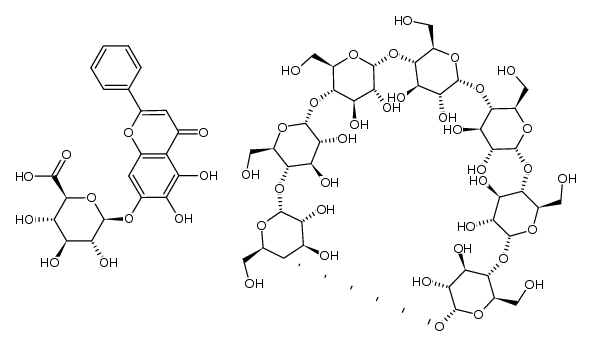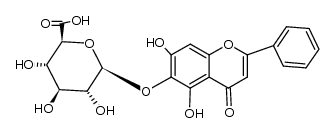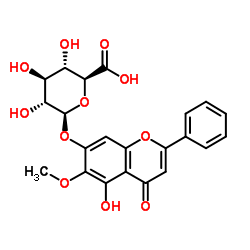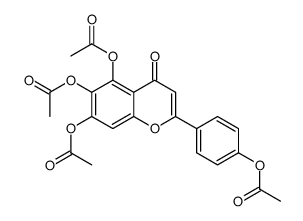21967-41-9
| Name | Baicalin |
|---|---|
| Synonyms |
5,6-Dihydroxy-4-oxo-2-phenyl-4H-1-benzopyran-7-yl β-D-Glucopyranosiduronic Acid
Acide α-D-glucopyranosiduronique de 5,6-dihydroxy-4-oxo-2-phényl-4H-chromén-7-yle BAICALIN Baicaloside 5,6-Dihydroxy-4-oxo-2-phenyl-4H-chromen-7-yl a-D-glucopyranosiduronic acid Baicailin MFCD00149302 (2S,3S,4S,5R,6R)-6-[(5,6-Dihydroxy-4-oxo-2-phenyl-4H-chromen-7-yl)oxy]-3,4,5-trihydroxytetrahydro-2H-pyran-2-carboxylic acid Baicalein 7-O-β-D-glucuronide Bassora Radix baicalein 7-O-glucuronide 5,6-Dihydroxy-4-oxo-2-phenyl-4H-chromen-7-yl α-D-glucopyranosiduronic acid |
| Description | Baicalin is a flavonoid glycoside isolated from Scutellaria baicalensis. Baicalin reduces the expression of NF-κB. |
|---|---|
| Related Catalog | |
| Target |
NF-κB Autophagy |
| In Vitro | Baicalin protects against ischemia-reperfusion injury (IRI) by altering the production of various mediators, including reactive oxygen species (ROS), Toll-like receptor (TLR)2 and TLR4, NF-κB, Bax, and Bcl-2. Baicalin treatment inhibits the increased expression of the proinflammatory cytokines TLR2/4, MyD88, p-NF-κB, and p- IκB, as well as increase the expression of IκB protein, an NF-κB inhibitor, with the degree of inhibition positively related to the dosage of Baicalin[1]. Cell viability is determined by MTT assay. Compared with control cells, cell viability is significantly decreased in SH-SY5Y cells treated with thrombin. Pre-treatment with Baicalin (5, 10, 20 μM) increases cell viability in a dose-dependent manner compared with cells treated thrombin alone[2]. |
| In Vivo | Baicalin pretreatment dose-dependently protects against a loss of renal function, with the two higher doses (10 and 100 mg/kg) significantly decreasing Scr and blood urea nitrogen (BUN) concentrations. Tissue injury, as assessed using a 0-3 point scoring system, is lower for the Baicalin treated groups than for the ischemia-reperfusion (IR)+saline group. Compared with the sham group, malondialdehyde (MDA) content is only slightly up-regulated and the SOD activity is only slightly down-regulated in rats treated with 10 and 100 mg/kg Baicalin, indicating that Baicalin abrogates the increase in oxidative stress following reperfusion[1]. |
| Cell Assay | SH-SY5Y cell lines are cultured in RPMI-1640 medium supplemented with 15% fetal bovine serum at 37°C in an air atmosphere containing 95% air and 5% CO2 with a saturated humidity. Upon a confluence of 60~70%, the SH-SY5Y cells are divided into: (i) control group, incubated in RPMI-1640 medium; (ii) thrombin group, which is subject to thrombin induction (40 U/L) for 6 h based on our pre-experiment; and (iii) Baicalin groups, which are treated by Baicalin (5 μM, 10 μM, or 20 μM) for 2 h before induction of thrombin. Cell viability is measured using MTT assay. Briefly, 15 μL of the MTT solution (5 mg/mL) is added to each well and incubated for 4 h at 37°C. After removing the supernatant, 80 μL DMSO are added into each well. The absorbance is measured at 492 nm using a microplate reader. All experiments are performed in triplicate[2]. |
| Animal Admin | Rats[1] Male Wistar rats weighing 200-250 g are used. Rats are randomly divided into five groups of six rats each: (i) sham group; (ii) IR+saline group; (iii) IR+Baicalin (1 mg/kg) group; (iv) IR+Baicalin (10 mg/kg) group; and (v) IR+Baicalin (100 mg/kg) group. Renal IRI is induced by clamping the left renal artery for 45 min plus a right nephrectomy. Rats are anesthetized through an intraperitoneal injection of pentobarbital sodium (40 mg/kg body weight). After a median abdominal incision, the left renal arteries are clamped for 45 min with serrefine. After clamp removal, adequate restoration of blood flow is checked before abdominal closure. The right kidney is then removed. Sham-operated animals underwent the same surgical procedure without clamping[1]. |
| References |
| Density | 1.7±0.1 g/cm3 |
|---|---|
| Boiling Point | 836.6±65.0 °C at 760 mmHg |
| Melting Point | 202-205 ºC |
| Molecular Formula | C21H18O11 |
| Molecular Weight | 446.361 |
| Flash Point | 297.2±27.8 °C |
| Exact Mass | 446.084900 |
| PSA | 187.12000 |
| LogP | 0.31 |
| Vapour Pressure | 0.0±3.2 mmHg at 25°C |
| Index of Refraction | 1.740 |
| Symbol |

GHS07 |
|---|---|
| Signal Word | Warning |
| Hazard Statements | H315-H319-H335 |
| Precautionary Statements | P305 + P351 + P338 |
| Hazard Codes | Xi: Irritant; |
| Risk Phrases | R36/37/38 |
| Safety Phrases | S26-S36 |
| RIDADR | NONH for all modes of transport |
| WGK Germany | 3 |
| RTECS | LZ5776910 |
| Precursor 8 | |
|---|---|
| DownStream 4 | |

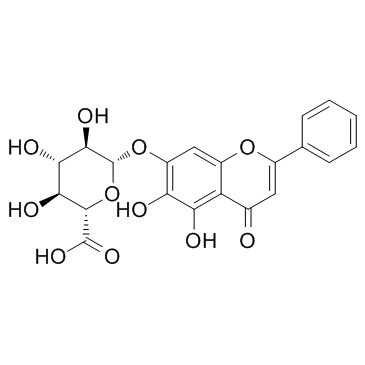
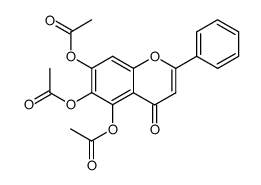
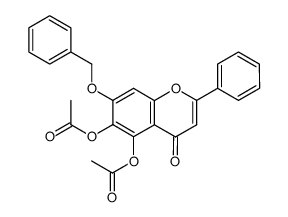
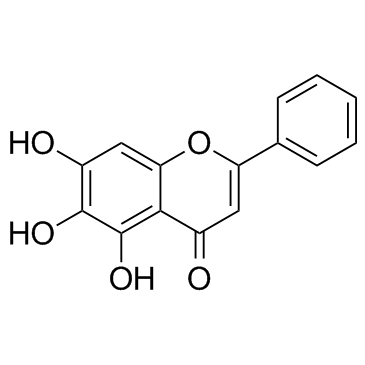
![(2S,3S,4R,5R,6R)-6-[[[(2S,3S,4R,5R)-5-(2,4-dioxopyrimidin-1-yl)-3,4-dihydroxy-oxolan-2-yl]methoxy-hydroxy-phosphoryl]oxy-hydroxy-phosphoryl]oxy-3,4,5-trihydroxy-oxane-2-carboxylic structure](https://image.chemsrc.com/caspic/281/2616-64-0.png)
